Help students reflect on the social and emotional aspects of the movie and consider the meaning of community.

Disney's Encanto is a movie about family, misunderstandings, healing, and forgiveness. Though these big concepts can be challenging for young students to grasp, Encanto approaches these subjects with a vibrant, lighthearted narrative—and a slew of extremely catchy songs.
By singing along and learning about each character, students are asked to explore the nature of identity and societal pressure. The movie can also push them to examine relationships within their own families and broader community. Through studying Mirabel's character, students can explore their own gifts and skills. Beyond that, kids can learn about how to apologize, forgive, and get along with those around them. While this movie guide is intended for first and second grade, the movie is great for all ages, and the guide is easy to adapt for older students.
Things to Know About This Guide
This guide offers two different approaches to teaching Encanto:
- Show a few specific clips, paired with discussion questions.
- Show the entire film, paired with a more in-depth lesson plan (below) and handout.
Feel free to use either approach, or even combine the two into one lesson (or an entire unit) based around the movie. If you only have a single class period, it might be ideal to show just a few key clips mentioned below. If you decide to help students delve deeper into the topic, you might show the entire film and have more extensive discussions over multiple days. Of course, you could also use some combination of the two, adapting the lesson to best suit your class's needs.
Lesson Objectives
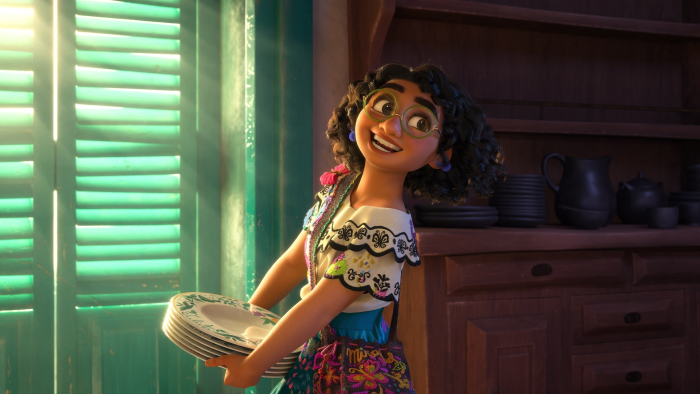
This lesson is designed to align with the CASEL 5 competencies for social and emotional learning as well as various thinking routines from the Harvard Graduate School of Education's Project Zero.
With this lesson, you can help your students:
- Develop interests and a sense of purpose
- Show the courage to take initiative
- Resist negative social pressure
- Reflect on one's role in promoting personal, family, and community well-being
- Resolve conflicts constructively
- Show concern for the feelings of others
- Identify solutions for personal and social problems
Encanto Clips and SEL Discussion Questions for Students
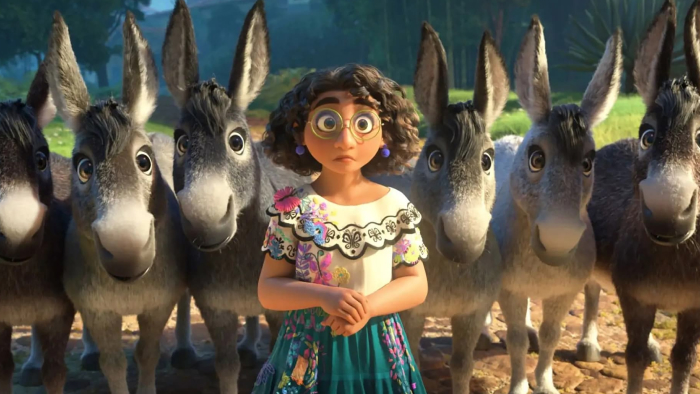
If you only want to show brief parts of the film and discuss them with students, use these helpful clip suggestions to get you started. You can also use these in conjunction with the longer lesson plan below.
The time stamps can help you pick and choose your areas of focus. Use as few or as many clips as you see fit, but keep in mind that you may need to introduce the movie's overall plot and talk through some of what happens before or after each clip.
Clip #1: The kids in the town ask Mirabel what her family members' "gifts" are. In the song "The Family Madrigal," Mirabel explains that her Tia Pepa's mood changes the weather, her mom can heal people with a meal, and so on. (3:00–9:50)
- What does it mean to have a "gift"?
- What skills or gifts do you have? What skills would your family say you have? Do you agree or disagree?
- What skills or gifts does your family (or people around you) have?
Clip #2: At Antonio's gift-getting ceremony, Abuela says the family uses their "blessings" (gifts) to help their "beloved community." (16:30–19:50)
- What is a community?
- Who is in your community?
- Take a look at this Rings of Responsibility lesson plan to explore how digital citizens take responsibility for themselves, their communities, and their world!
- Consider tacking on this lesson that helps students envision their online communities and who is in them.
- How can people use their special skills to help their community?
Clip #3: When Antonio gets the power of being able to understand animals, the family is excited and gathers around to take a photo together—but without Mirabel. (19:50–24:55)
- Note: This is related to the "While You Watch" activity in the Active Viewing Guide.
- What emotion do you think Mirabel is feeling when she sees her family taking a picture without her? Why do you think she feels that way?
- How does it feel to be left out of a community or feel like you don't belong? How important is it to feel like you belong? Why?
Clip #4: In the song "Surface Pressure," Luisa says she feels "pressure" to help family and neighbors with heavy tasks. (33:16–37:47)
- What does it mean to be "under pressure" from family or friends?
- How does it feel to be under pressure from people who love you?
- How does Luisa feel about being under pressure to help people she cares about?
- Who are some other people pressure can come from?
Clip #5: In the song "We Don't Talk About Bruno," we hear many different family members' points of view on Bruno. Pepa and Félix sing about how he ruined their wedding day, and Dolores mentions she can hear him from time to time. (46:00–49:30)
- Each character shares their point of view about Bruno. What is a "point of view"?
- Note: Before introducing this concept here, you can teach about points of view with a fairy tale like Henny Penny or the Three Little Pigs.
Clip #6: When Mirabel finally finds Bruno hiding in the house, she has a lot of questions for him about why he left the family. He says he left because the family didn't understand him or his visions. (53:40–1:01:22)
- Discuss: What is a personality? What are some personality traits? (Make a list as a group.)
- Is Bruno's personality what you thought? Why or why not?
- Have you ever talked with someone who was not like you thought they would be?
Clip #7: When Mirabel finally convinces Bruno to try to have another "vision," he thinks he sees Mirabel and Isabela hugging and the casita being fixed. He tells Mirabel that to make the candle bright, she has to "embrace" Isabela. (1:02:08–1:05)
- What does it mean to "embrace" someone?
- How does Mirabel feel about needing to get closer to and connect with Isabela to save the miracle?
- Why doesn't Mirabel get along with Isabela?
Clip #8: When Mirabel goes to visit Isabela and tries to hug her, Isabela doesn't accept her apology right away. At the end of the scene, they finally hug and forgive each other. (1:06:28–1:11:40)
- What does it mean to forgive someone?
- What changes in this scene that makes them forgive each other?
Clip #9: In Isabela's song "What Else Can I Do?," she sings, "What could I do if I just knew it didn't need to be perfect?" Isabela is excited about all of the possibilities now that she doesn't have to pretend to be perfect for her family. (1:08:45–1:11:40)
- Is it possible for someone to be perfect? Why or why not?
Clip #10: Mirabel is excited to tell Abuela that she and Isabela saved the miracle. Abuela blames Mirabel for the house breaking and ruining her family's powers. Mirabel is upset and tells Abuela she will "never be good enough." (1:11:40–11:13:32)
- Do you think it was OK for Mirabel to talk to her grandmother like this at this moment? Why or why not?
Clip #11: Abuela finds Mirabel crying and we see the full story of why they left their hometown in the first place, from Abuela's point of view. Abuela apologizes for how she has been treating Mirabel and says she was doing it to protect the family. (1:16:58–1:23:21)
- Why was Abuela protective over the family and the miracle?
- If you were Mirabel, would you forgive Abuela?
Clip #12: Mirabel tells Abuela that nothing can ever be broken that we can't fix together. She then returns to find that the house is completely destroyed. (1:21:46–1:24:10)
- How did the family Madrigal come together to fix the house?
- When have you ever worked with a group to solve a problem?
- Discuss: How did you solve the problem?
- As an extension activity: Ask students to share a time they forgave someone after an argument. Or ask them to fold a piece of paper in three (or use a digital tool) to draw a three-frame picture of a disagreement, an apology, and what happened after.
Clip #13: After the family works together to rebuild the house, the family sings that the house isn't perfect and neither are they. (1:24:10–1:31:00)
- How is the family able to be happy even though they aren't perfect?
Encanto SEL Lesson Plan and Graphic Organizer
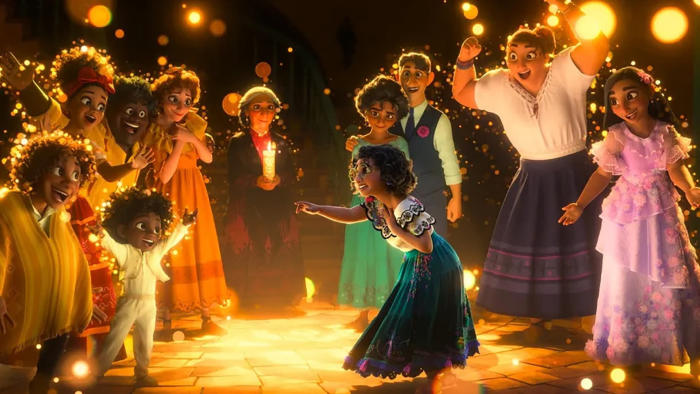
Begin by introducing the movie and give students some context about why it's worth thinking about more deeply. A lot of students may have seen the movie already, so make a strict "If you know it, don't blow it" rule to prevent spoilers. You might also want to discuss some of the learning objectives or the concept of active viewing.
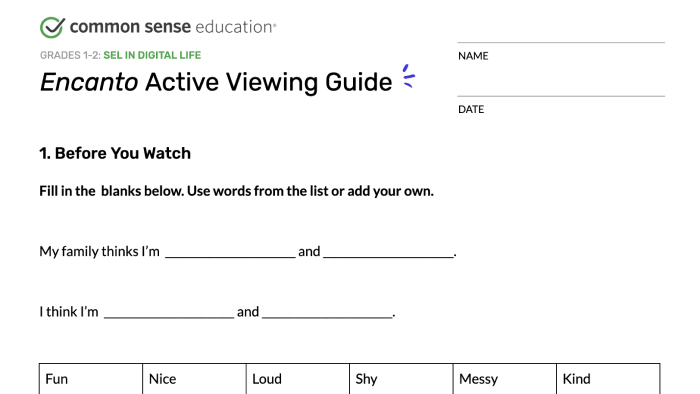
Before the Movie
Hand out copies of the Encanto Active Viewing Guide, and give students a few minutes to finish the Before You Watch question.
- Ask students to describe themselves with vocabulary words. Then have them complete a sentence to illustrate how their family would describe them.
- Importantly, they'll return to this after the movie and reflect on it in the last question. It's essential that students do both the first and last questions on the handout to document how their perception of themselves changes over time. Before you start the movie, explain the next activity that students will complete while they watch.
During the Movie
- While watching the movie, ask students to pay attention to how characters describe Bruno. After the song "We Don't Talk About Bruno" at 46:00–49:30, pause the movie so they can write descriptive words in the box or draw a picture of how Bruno is perceived.
After the Movie
- Have students look back at question two of the Active Viewing Guide. Have students reflect on Bruno's description and how he is different from how he was depicted by the Madrigal family.
- Note: Students can write down their responses individually, then discuss in pairs, small groups, and/or as a whole class.
- Ask students to complete new sentences with what they've learned about Bruno's character after meeting him. Then have students share one fun fact about themselves with the class.
- After the movie ends, it's important to help students reflect on what they've seen and talk about what they're thinking. You can discuss anything that feels particularly relevant to your students. The scenes and discussion questions can be a good starting point, but feel free to guide your class discussion as you see fit.
Creative Extensions
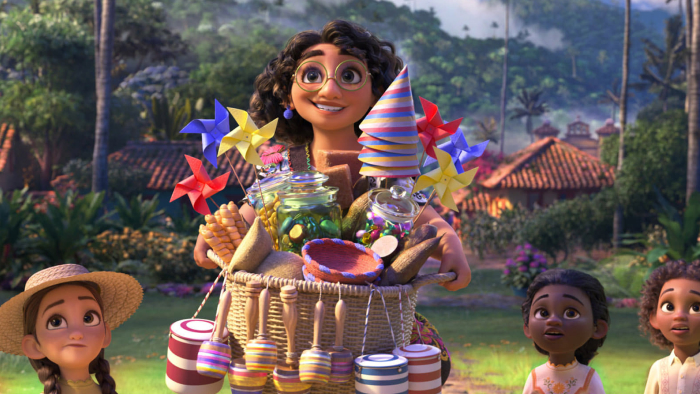
- To celebrate culture and identity, have students create a Venn diagram to compare and contrast the way their lives are similar or different from Mirabel's. You can get them started by discussing the setting, clothing, and food shown in the movie.
- Watch another movie that explores similar themes but from a different cultural perspective. Invite students to consider how these movies present the issues of family and societal expectations. Each of the films tells a story about how different communities come together to support each other. Whether it's Mirabel in Encanto gaining the support of her extended family to save the miracle, Miguel in Coco meeting friends who empower him to live his musical dream, or Moana saving her island with the aid of her unlikely companion Maui, all of these films highlight the importance of teamwork in allowing the characters to live out their true purpose.
- Coco
- Moana
- Turning Red







